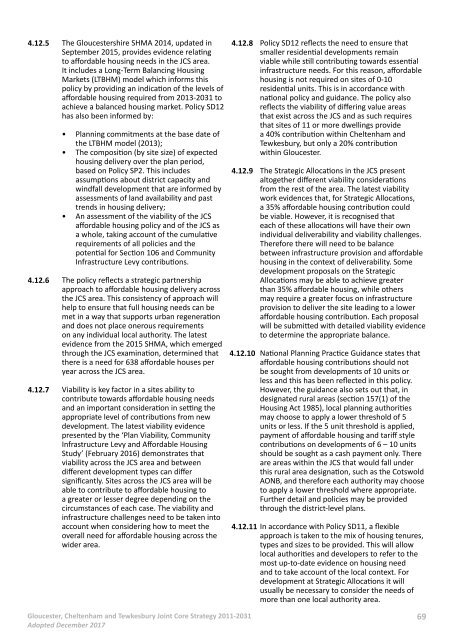JCS_MasterDocument_FIN_27.03.18
You also want an ePaper? Increase the reach of your titles
YUMPU automatically turns print PDFs into web optimized ePapers that Google loves.
4.12.5<br />
4.12.6<br />
4.12.7<br />
The Gloucestershire SHMA 2014, updated in<br />
September 2015, provides evidence relating<br />
to affordable housing needs in the <strong>JCS</strong> area.<br />
It includes a Long-Term Balancing Housing<br />
Markets (LTBHM) model which informs this<br />
policy by providing an indication of the levels of<br />
affordable housing required from 2013-2031 to<br />
achieve a balanced housing market. Policy SD12<br />
has also been informed by:<br />
• Planning commitments at the base date of<br />
the LTBHM model (2013);<br />
• The composition (by site size) of expected<br />
housing delivery over the plan period,<br />
based on Policy SP2. This includes<br />
assumptions about district capacity and<br />
windfall development that are informed by<br />
assessments of land availability and past<br />
trends in housing delivery;<br />
• An assessment of the viability of the <strong>JCS</strong><br />
affordable housing policy and of the <strong>JCS</strong> as<br />
a whole, taking account of the cumulative<br />
requirements of all policies and the<br />
potential for Section 106 and Community<br />
Infrastructure Levy contributions.<br />
The policy reflects a strategic partnership<br />
approach to affordable housing delivery across<br />
the <strong>JCS</strong> area. This consistency of approach will<br />
help to ensure that full housing needs can be<br />
met in a way that supports urban regeneration<br />
and does not place onerous requirements<br />
on any individual local authority. The latest<br />
evidence from the 2015 SHMA, which emerged<br />
through the <strong>JCS</strong> examination, determined that<br />
there is a need for 638 affordable houses per<br />
year across the <strong>JCS</strong> area.<br />
Viability is key factor in a sites ability to<br />
contribute towards affordable housing needs<br />
and an important consideration in setting the<br />
appropriate level of contributions from new<br />
development. The latest viability evidence<br />
presented by the ‘Plan Viability, Community<br />
Infrastructure Levy and Affordable Housing<br />
Study’ (February 2016) demonstrates that<br />
viability across the <strong>JCS</strong> area and between<br />
different development types can differ<br />
significantly. Sites across the <strong>JCS</strong> area will be<br />
able to contribute to affordable housing to<br />
a greater or lesser degree depending on the<br />
circumstances of each case. The viability and<br />
infrastructure challenges need to be taken into<br />
account when considering how to meet the<br />
overall need for affordable housing across the<br />
wider area.<br />
4.12.8<br />
4.12.9<br />
4.12.10<br />
Policy SD12 reflects the need to ensure that<br />
smaller residential developments remain<br />
viable while still contributing towards essential<br />
infrastructure needs. For this reason, affordable<br />
housing is not required on sites of 0-10<br />
residential units. This is in accordance with<br />
national policy and guidance. The policy also<br />
reflects the viability of differing value areas<br />
that exist across the <strong>JCS</strong> and as such requires<br />
that sites of 11 or more dwellings provide<br />
a 40% contribution within Cheltenham and<br />
Tewkesbury, but only a 20% contribution<br />
within Gloucester.<br />
The Strategic Allocations in the <strong>JCS</strong> present<br />
altogether different viability considerations<br />
from the rest of the area. The latest viability<br />
work evidences that, for Strategic Allocations,<br />
a 35% affordable housing contribution could<br />
be viable. However, it is recognised that<br />
each of these allocations will have their own<br />
individual deliverability and viability challenges.<br />
Therefore there will need to be balance<br />
between infrastructure provision and affordable<br />
housing in the context of deliverability. Some<br />
development proposals on the Strategic<br />
Allocations may be able to achieve greater<br />
than 35% affordable housing, while others<br />
may require a greater focus on infrastructure<br />
provision to deliver the site leading to a lower<br />
affordable housing contribution. Each proposal<br />
will be submitted with detailed viability evidence<br />
to determine the appropriate balance.<br />
National Planning Practice Guidance states that<br />
affordable housing contributions should not<br />
be sought from developments of 10 units or<br />
less and this has been reflected in this policy.<br />
However, the guidance also sets out that, in<br />
designated rural areas (section 157(1) of the<br />
Housing Act 1985), local planning authorities<br />
may choose to apply a lower threshold of 5<br />
units or less. If the 5 unit threshold is applied,<br />
payment of affordable housing and tariff style<br />
contributions on developments of 6 – 10 units<br />
should be sought as a cash payment only. There<br />
are areas within the <strong>JCS</strong> that would fall under<br />
this rural area designation, such as the Cotswold<br />
AONB, and therefore each authority may choose<br />
to apply a lower threshold where appropriate.<br />
Further detail and policies may be provided<br />
through the district-level plans.<br />
4.12.11 In accordance with Policy SD11, a flexible<br />
approach is taken to the mix of housing tenures,<br />
types and sizes to be provided. This will allow<br />
local authorities and developers to refer to the<br />
most up-to-date evidence on housing need<br />
and to take account of the local context. For<br />
development at Strategic Allocations it will<br />
usually be necessary to consider the needs of<br />
more than one local authority area.<br />
Gloucester, Cheltenham and Tewkesbury Joint Core Strategy 2011-2031<br />
Adopted December 2017<br />
69




